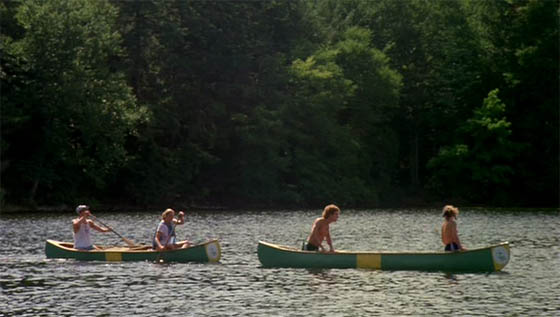 As a child, my summer camp experiences were pretty limited. My parents used to take me to a place called “Family Camp,” a Christian-themed, family-and-kids get-together amidst the towering redwood trees of northern California; but I was never long separated from my parents. In elementary school, a two-day field trip to the Wisconsin northwoods finally had me bunking with my fellow classmates, suffering through dull arts-and-crafts sessions, canoeing, and singing and telling stories while roasting marshmallows around a campfire. That was only for one or two nights, though. I’m left to the movies to have the summer camp experience properly explained to me. So this brings us to today’s double feature, a full immersion into summer camp of the late 70’s and early 80’s, to see just what experiences I missed as a youth. And it’s clearer to me now. I missed out.
As a child, my summer camp experiences were pretty limited. My parents used to take me to a place called “Family Camp,” a Christian-themed, family-and-kids get-together amidst the towering redwood trees of northern California; but I was never long separated from my parents. In elementary school, a two-day field trip to the Wisconsin northwoods finally had me bunking with my fellow classmates, suffering through dull arts-and-crafts sessions, canoeing, and singing and telling stories while roasting marshmallows around a campfire. That was only for one or two nights, though. I’m left to the movies to have the summer camp experience properly explained to me. So this brings us to today’s double feature, a full immersion into summer camp of the late 70’s and early 80’s, to see just what experiences I missed as a youth. And it’s clearer to me now. I missed out.
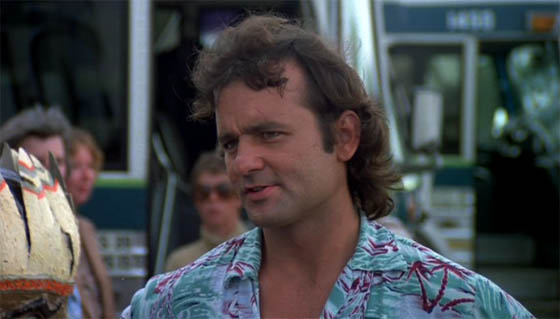 I also missed out on Meatballs (1979), which I’d never seen prior to now. I’m not exactly sure how I avoided it, since as a kid of the Ghostbusters era I was naturally a Bill Murray fan, but I can tell you that the only films in this franchise I viewed as an adolescent were the third (horrible) and fourth (Corey Feldman), so I never really associated the series with good things. Today you have to watch this film with nostalgia, I’m afraid, or you won’t get much out of it at all. Murray, fresh off Saturday Night Live, chews the scenery mercilessly, rarely sticks to the script, and basically becomes a movie star, immediately, but in the most undignified way possible. It was a time when irreverence was enough. Much of what Murray says (or improvises) is funny, but a surprising amount settles for smug rather than clever. To be fair, he has little to go on here. Director Ivan Reitman (Ghostbusters) is creating a genre, the Summer Camp Movie, with an ensemble cast of mostly unfamiliar faces, and a “plot” which is really just a collection of gags on the way to a rote climax (a competition between two rival summer camps, i.e. the slobs vs. the snobs). Though PG-rated, it owes much to Animal House (1978), which was co-written by Harold Ramis. Ramis went on to direct a further variation on the formula with Caddyshack (1980); both are better, funnier films than Meatballs. It’s fair to say that Murray owns this film, though he casts such a large shadow that I’d be curious to see what the film would look like without him.
I also missed out on Meatballs (1979), which I’d never seen prior to now. I’m not exactly sure how I avoided it, since as a kid of the Ghostbusters era I was naturally a Bill Murray fan, but I can tell you that the only films in this franchise I viewed as an adolescent were the third (horrible) and fourth (Corey Feldman), so I never really associated the series with good things. Today you have to watch this film with nostalgia, I’m afraid, or you won’t get much out of it at all. Murray, fresh off Saturday Night Live, chews the scenery mercilessly, rarely sticks to the script, and basically becomes a movie star, immediately, but in the most undignified way possible. It was a time when irreverence was enough. Much of what Murray says (or improvises) is funny, but a surprising amount settles for smug rather than clever. To be fair, he has little to go on here. Director Ivan Reitman (Ghostbusters) is creating a genre, the Summer Camp Movie, with an ensemble cast of mostly unfamiliar faces, and a “plot” which is really just a collection of gags on the way to a rote climax (a competition between two rival summer camps, i.e. the slobs vs. the snobs). Though PG-rated, it owes much to Animal House (1978), which was co-written by Harold Ramis. Ramis went on to direct a further variation on the formula with Caddyshack (1980); both are better, funnier films than Meatballs. It’s fair to say that Murray owns this film, though he casts such a large shadow that I’d be curious to see what the film would look like without him.
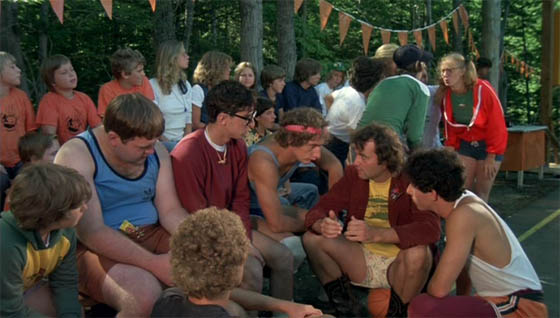 That doesn’t mean I’m anxious to watch Meatballs Part II. What it does mean is that Reitman takes an interesting approach to the film, which is to fill the cast with appealingly fresh-faced kids and teenagers, not just twenty-somethings trying to pass as kids. The extras in the background of every scene are clearly real kids having fun, giving the feel of summer camp, and a warmth, that is much more endearing than Elmer Bernstein’s cloying score (and I say this as a fan of Bernstein’s, in particular his work on the Reitman-produced Heavy Metal). As for the cast’s principals: they shine, and come off as exact characters, many of them accomplishing this without exposition explaining who they are or what has brought them here. Notice, for example, how blonde teen A.L. (Kristine DeBell), though she has just a hint of a romantic subplot, finds something to do in every scene without the film having to bend over backward to give us a fully-developed “arc.” She’s really just a believable, semi-popular, slightly tomboyish teenage girl who is neither heroic nor vilified – just getting by and having fun. I believed her, as I did most of the rest of the campers. That is nice to see. (I feel obligated to mention that the innocent-looking DeBell was in the X-rated musical of Alice in Wonderland [1976]. I appreciate that she got cast in Meatballs anyway.)
That doesn’t mean I’m anxious to watch Meatballs Part II. What it does mean is that Reitman takes an interesting approach to the film, which is to fill the cast with appealingly fresh-faced kids and teenagers, not just twenty-somethings trying to pass as kids. The extras in the background of every scene are clearly real kids having fun, giving the feel of summer camp, and a warmth, that is much more endearing than Elmer Bernstein’s cloying score (and I say this as a fan of Bernstein’s, in particular his work on the Reitman-produced Heavy Metal). As for the cast’s principals: they shine, and come off as exact characters, many of them accomplishing this without exposition explaining who they are or what has brought them here. Notice, for example, how blonde teen A.L. (Kristine DeBell), though she has just a hint of a romantic subplot, finds something to do in every scene without the film having to bend over backward to give us a fully-developed “arc.” She’s really just a believable, semi-popular, slightly tomboyish teenage girl who is neither heroic nor vilified – just getting by and having fun. I believed her, as I did most of the rest of the campers. That is nice to see. (I feel obligated to mention that the innocent-looking DeBell was in the X-rated musical of Alice in Wonderland [1976]. I appreciate that she got cast in Meatballs anyway.)
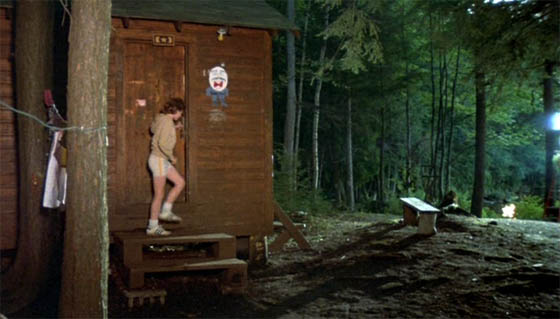 I always have a bit of difficulty trying to express this criticism of Pixar, but as great as their films often are, I always get the feeling that there have been a few too many story meetings – that every corner has been scrubbed clean to serve the express, focused purpose of the story and themes. Life is not so neatly arranged. Everyone is participating in their own story, of course, but we cross paths with one another at different points in our own individual character arcs. One person’s catharsis might occur when another is just in the opening passages of his own personal narrative. Our plotlines don’t all tie up neatly and at the same moment. Okay, so Reitman can’t resist serving up a couple of character arcs that do tie up pretty neatly by the end of summer camp, and this is exactly what gives Wet Hot American Summer (2001) so much to parody. There is a character called Spaz (Jack Blum). He has thick white tape on his glasses. At a certain point, he finds romance (kinda). There’s a gag that his father has tape on his glasses too. Yes, the film does this, and you can cringe.
I always have a bit of difficulty trying to express this criticism of Pixar, but as great as their films often are, I always get the feeling that there have been a few too many story meetings – that every corner has been scrubbed clean to serve the express, focused purpose of the story and themes. Life is not so neatly arranged. Everyone is participating in their own story, of course, but we cross paths with one another at different points in our own individual character arcs. One person’s catharsis might occur when another is just in the opening passages of his own personal narrative. Our plotlines don’t all tie up neatly and at the same moment. Okay, so Reitman can’t resist serving up a couple of character arcs that do tie up pretty neatly by the end of summer camp, and this is exactly what gives Wet Hot American Summer (2001) so much to parody. There is a character called Spaz (Jack Blum). He has thick white tape on his glasses. At a certain point, he finds romance (kinda). There’s a gag that his father has tape on his glasses too. Yes, the film does this, and you can cringe.
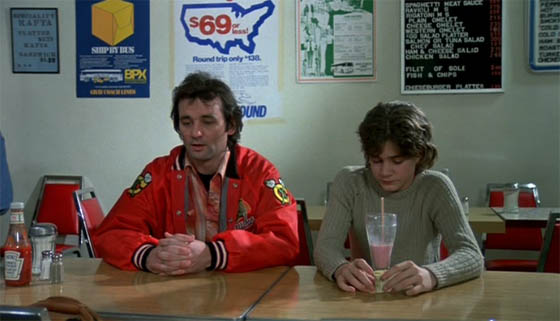 But I cringed a lot more at the tale of Rudy (Chris Makepeace), the social outcast whom Murray’s Tripper takes under his wing, to teach him important life lessons. It’s Rudy who wins the big race at the end, as the inspiring music rises. It’s Rudy who has big puppy dog eyes that look with almost absurd admiration at Tripper. And he will look at you, and he will look into your soul too, and you will weep for your pet rabbit who died when you were only five years old, and if only you could recapture the innocence of those days again. Rudy ostensibly helpes Tripper with his life, as well, by trying to get him to admit that he actually cares for fellow camp counsellor Roxanne (Kate Lynch). But we know that Tripper and Roxanne would end up together with or without this little moppet delivering lines like, “You really like Roxanne, don’t you?”
But I cringed a lot more at the tale of Rudy (Chris Makepeace), the social outcast whom Murray’s Tripper takes under his wing, to teach him important life lessons. It’s Rudy who wins the big race at the end, as the inspiring music rises. It’s Rudy who has big puppy dog eyes that look with almost absurd admiration at Tripper. And he will look at you, and he will look into your soul too, and you will weep for your pet rabbit who died when you were only five years old, and if only you could recapture the innocence of those days again. Rudy ostensibly helpes Tripper with his life, as well, by trying to get him to admit that he actually cares for fellow camp counsellor Roxanne (Kate Lynch). But we know that Tripper and Roxanne would end up together with or without this little moppet delivering lines like, “You really like Roxanne, don’t you?”
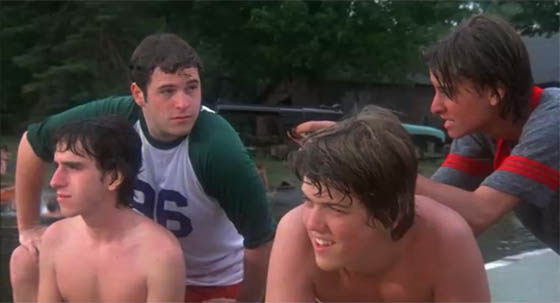 This big brother relationship, of camp counsellor nurturing the social misfit, recurs in The Burning (1981), but, I’d argue, it’s to more satisfying ends. Alfred (Brian Backer) can’t help spying on the girl of his dreams, Sally (Carrick Glenn); when he causes a furor by sneaking into the girl’s showers to get a better look, Counsellor Todd (Brian Matthews) takes him on as his personal responsibility, only without using nonstop improvisational comedy as a tool. No, the wisecracks here are delivered by class clown Dave, played by a pre-Seinfeld Jason Alexander. As class clowns typically will, Dave offers détente amongst the various cliques, and is friend to nerd and jock alike (to the former, by providing Playboys and Hustlers; to the latter, by supplying condoms). Like a few other actors here, he does look a bit too old to be attending summer camp, but The Burning gains back some verisimilitude in other ways, mainly the lazy pace of summer camp life, where the chirping of crickets under the raised wooden sheds are disturbed only by the sounds of splashing water or the persistent laughter of children and teens. Oh, I should mention: this is a horror movie. Unlike its immediate predecessor, Friday the 13th (1980), The Burning is more interested in establishing the milieu than charging ahead with slasher movie formulaics (though the stock opening scenes get some of that out of the way, so its teenage audience doesn’t get too restless).
This big brother relationship, of camp counsellor nurturing the social misfit, recurs in The Burning (1981), but, I’d argue, it’s to more satisfying ends. Alfred (Brian Backer) can’t help spying on the girl of his dreams, Sally (Carrick Glenn); when he causes a furor by sneaking into the girl’s showers to get a better look, Counsellor Todd (Brian Matthews) takes him on as his personal responsibility, only without using nonstop improvisational comedy as a tool. No, the wisecracks here are delivered by class clown Dave, played by a pre-Seinfeld Jason Alexander. As class clowns typically will, Dave offers détente amongst the various cliques, and is friend to nerd and jock alike (to the former, by providing Playboys and Hustlers; to the latter, by supplying condoms). Like a few other actors here, he does look a bit too old to be attending summer camp, but The Burning gains back some verisimilitude in other ways, mainly the lazy pace of summer camp life, where the chirping of crickets under the raised wooden sheds are disturbed only by the sounds of splashing water or the persistent laughter of children and teens. Oh, I should mention: this is a horror movie. Unlike its immediate predecessor, Friday the 13th (1980), The Burning is more interested in establishing the milieu than charging ahead with slasher movie formulaics (though the stock opening scenes get some of that out of the way, so its teenage audience doesn’t get too restless).
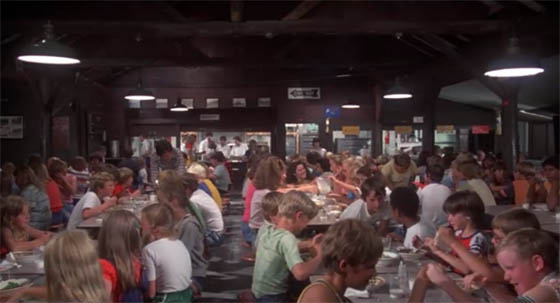 A very early film in the history of Miramax, The Burning was directly fostered by the Weinsteins: Bob Weinstein co-wrote the script and Harvey Weinstein was producer. It was actually written before Friday the 13th, but quickly completed to cash in on that film’s success. Frankly, I’ve always preferred The Burning. Inspired by the legend of “Cropsy” – the truth behind which is analyzed in the excellent 2009 documentary of the same name – the essential function of the film is to act as a campfire legend brought to life. But what separates The Burning from the Jason Voorhees movies is that this film wants you to get to know and understand all of these kids before they start dying. Cropsy’s summer camp murder spree doesn’t properly begin until we’re well over halfway through the film; and, even though makeup artist Tom Savini puts his typically detailed work into every bloody killing, because we’ve gotten to like these kids, their deaths have a tragic feeling which is missing from every last one of the Friday the 13ths (and, in fact, far too much of the slasher genre). When the bodies are discovered, there’s also time given to panic, grieving, and a scramble to get the camp counsellors notified and the police summoned. It just feels more real and human than the strict, plodding Friday the 13th formula would ever allow. And in that, it shares an affinity with Meatballs, which also likes to temper its over-the-top moments with something more recognizably human.
A very early film in the history of Miramax, The Burning was directly fostered by the Weinsteins: Bob Weinstein co-wrote the script and Harvey Weinstein was producer. It was actually written before Friday the 13th, but quickly completed to cash in on that film’s success. Frankly, I’ve always preferred The Burning. Inspired by the legend of “Cropsy” – the truth behind which is analyzed in the excellent 2009 documentary of the same name – the essential function of the film is to act as a campfire legend brought to life. But what separates The Burning from the Jason Voorhees movies is that this film wants you to get to know and understand all of these kids before they start dying. Cropsy’s summer camp murder spree doesn’t properly begin until we’re well over halfway through the film; and, even though makeup artist Tom Savini puts his typically detailed work into every bloody killing, because we’ve gotten to like these kids, their deaths have a tragic feeling which is missing from every last one of the Friday the 13ths (and, in fact, far too much of the slasher genre). When the bodies are discovered, there’s also time given to panic, grieving, and a scramble to get the camp counsellors notified and the police summoned. It just feels more real and human than the strict, plodding Friday the 13th formula would ever allow. And in that, it shares an affinity with Meatballs, which also likes to temper its over-the-top moments with something more recognizably human.
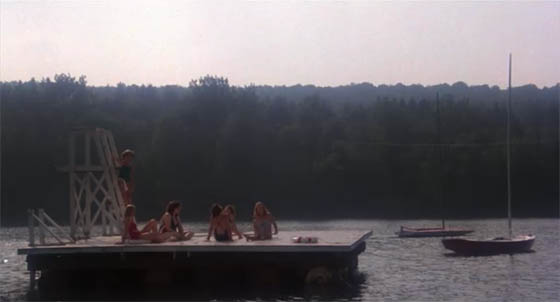 Though Meatballs and The Burning belong to different genres, they’re both “summer camp” films, and so you can’t help but notice the parallels. Both have a centerpiece canoe trip to camp overnight downriver, with the campers plotting to exploit the opportunity for close encounters with the opposite sex. In Meatballs, most everyone scores. In The Burning, a couple of them score, but about half of them are brutally murdered by Cropsy’s giant garden shears. (The two films also entertain the cliché of the camera panning slowly across discarded clothing before arriving at the blissful lovers. But appreciate that The Burning uses the moment to illustrate that first-time sex is sometimes not that blissful, and can be a little disappointing.) Both films feature a spooky tale told by the campfire, though Bill Murray’s tale of a hook-handed killer is not actually ironic foreshadowing of any events which follow. Both hit summer camp touchstones of sports competitions, crowded cafeterias, and gawking lakeside at girls in bikinis. Bill Murray orchestrates elaborate pranks on Morty (Harvey Atkin), the camp leader, in which he and his young charges sneak into Morty’s room late at night, and move the sleeping Morty – and his bed – to various uncomfortable places outdoors, to his chagrin. The Burning‘s prank involves young campers sneaking into the room of camp janitor Cropsy and setting up a worm-covered skull with candles by his bedside, which, when he wakes, causes him to thrash about in terror, knock over the candle, light his entire room on fire, and stumble outside covered in flames. To his chagrin. And subsequent ritualistic slaughter of camping teenagers.
Though Meatballs and The Burning belong to different genres, they’re both “summer camp” films, and so you can’t help but notice the parallels. Both have a centerpiece canoe trip to camp overnight downriver, with the campers plotting to exploit the opportunity for close encounters with the opposite sex. In Meatballs, most everyone scores. In The Burning, a couple of them score, but about half of them are brutally murdered by Cropsy’s giant garden shears. (The two films also entertain the cliché of the camera panning slowly across discarded clothing before arriving at the blissful lovers. But appreciate that The Burning uses the moment to illustrate that first-time sex is sometimes not that blissful, and can be a little disappointing.) Both films feature a spooky tale told by the campfire, though Bill Murray’s tale of a hook-handed killer is not actually ironic foreshadowing of any events which follow. Both hit summer camp touchstones of sports competitions, crowded cafeterias, and gawking lakeside at girls in bikinis. Bill Murray orchestrates elaborate pranks on Morty (Harvey Atkin), the camp leader, in which he and his young charges sneak into Morty’s room late at night, and move the sleeping Morty – and his bed – to various uncomfortable places outdoors, to his chagrin. The Burning‘s prank involves young campers sneaking into the room of camp janitor Cropsy and setting up a worm-covered skull with candles by his bedside, which, when he wakes, causes him to thrash about in terror, knock over the candle, light his entire room on fire, and stumble outside covered in flames. To his chagrin. And subsequent ritualistic slaughter of camping teenagers.
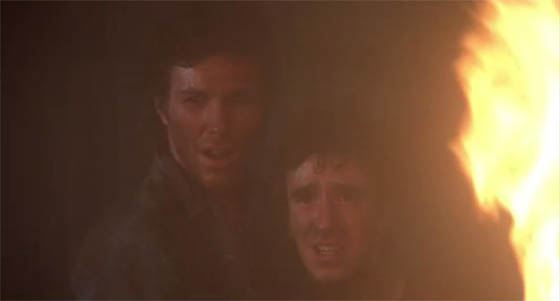 But which plotline is more emotionally rewarding? Bill Murray teaching Rudy self-confidence and pride, so that when the moment comes, the boy can win the track race which allows the camp of misfits to triumph over their snobby neighbors? Or Counsellor Todd bonding with social pariah Alfred as the two of them confront Cropsy in his secret hiding place, where Alfred stabs him through the chest with the killer’s own garden shears, Todd sinks an axe into his head, and they both set fire to him once again just as the police finally arrive? All I’m suggesting is that Bill Murray will probably forget snot-nosed Rudy by next summer, but Alfred and Counsellor Todd will carry their moments together for the rest of their lives. Albeit in a kind of Stephen King’s It kind of way. Still, it’s a bond that holds.
But which plotline is more emotionally rewarding? Bill Murray teaching Rudy self-confidence and pride, so that when the moment comes, the boy can win the track race which allows the camp of misfits to triumph over their snobby neighbors? Or Counsellor Todd bonding with social pariah Alfred as the two of them confront Cropsy in his secret hiding place, where Alfred stabs him through the chest with the killer’s own garden shears, Todd sinks an axe into his head, and they both set fire to him once again just as the police finally arrive? All I’m suggesting is that Bill Murray will probably forget snot-nosed Rudy by next summer, but Alfred and Counsellor Todd will carry their moments together for the rest of their lives. Albeit in a kind of Stephen King’s It kind of way. Still, it’s a bond that holds.









